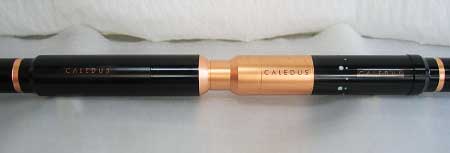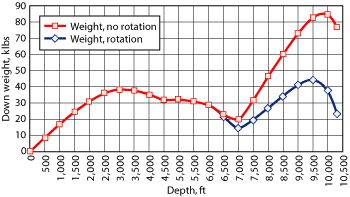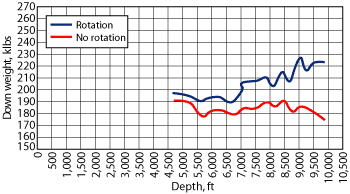Single-tool technology bypasses the use of drill collars while increasing available surface weight.
Paul Howlett, Caledus
Allowing string rotation above sand-control screens and liners in high-angle/ERD or tortous wells helps achieve getting to TD. This ability to rotate the drill pipe is advantageous because drag is reduced in the rotating pipe string, creating more available weight at surface in case screens need to be pushed in place. If there is a requirement to convert the string to a fully locked string and if torque needs to be transmitted below the tool, then simply pressuring up and engaging a clutch mechanism enables full drill-pipe torque to be transmitted below the tool.
INTRODUCTION
Using the new SwivelMASTER (Fig. 1) as a single tool eliminates the need for picking up drill collars or Hevi-Wate drill pipe to make more surface weight available. This saves time, enhances safety and eliminates unnecessary manual handling. Alternative applications using numerous drill-pipe-based roller bearing subs took significant time to pick up and lay out, increased manual handling and cost, and added additional drill pipe connections in the string. Overall the tool is safer and quicker to deploy and allows more controlled download to push screens into place. The ability to view the applied download, like WOB, when pushing screens into place can ensure that no damaging compression loads are applied.
 |
|
Fig. 1. Close-up view of the swivel tool.
|
|
The following objectives were met during testing of this tool:
- Additional surface weight was available.
- The tool functioned without any problems.
After recording the down weights (both rotating and non-rotating) while tripping to TD with the tool in its swivel position, it was then converted to the locked position, during the packer-setting sequence. The setting sequence involved holding pressure at 1,500 psi, 2,500 psi and then 3,500 psi, in five-min. intervals, during which time the tool locked, as the conversion pressure of the sliding sleeve was set to shear at 1,375 psi. Confirmation that the tool had locked occurred when it was POOH and passed through the rotary table.
A 130% increase (39,900 lb-91,400 lb) of additional weight became available when the string reached TD, as recorded from drill-floor data, after subtracting the block weight of 150,000 lb.
BACKGROUND AND PREPARATION
The field run was performed for a North Sea operator on a semisubmersible rig, with a 15-hr screen run. Down weights (rotating and non-rotating) were recorded; up weights were not recorded with the screens in open hole. The running string itself consisted of about 4,400 ft of screen assembly and 70 ft of various assemblies, including running tool and packer assemblies. Above this was a single stand of 5-in drill pipe underneath the tool assembly. As part of the tool’s assembly, a DartCATCHER sub was run immediately below. This sub can be used to land a dart, pressure up and to convert the tool, but is only required in unusual circumstances. Above the tool, the string consisted of a mixture of 5½-in. conventional drillpipe and Hevi-Wate drill pipe.
A torque-and-drag analysis was conducted for the string at TD, to show the anticipated difference in surface hookload, while TIH, between a) running a conventional static string and b) using a combined string with the tool, which allows rotation above the tool, with the string below remaining static, Fig. 2. Hookload for the static string was 173,500 lb, while for the combined string it was 226,900 lb for a difference of 53,400 lb. The results were reached using a friction factor of 0.31 for cased hole and 0.55 for open hole.
 |
|
Fig. 2. Estimated hookload comparison (down-weight only) of the new swivel tool (rotation) vs. no rotation.
|
|
PROCEDURE
The following objectives were sought during this run:
- Additional weight available at surface, when the tool was used in rotation vs. no-rotation
- Screen running procedure to go as planned, unaffected by the tool-running procedure or operation.
During the screen-string RIH, several test steps were established to reveal the advantage of running the tool vs. a conventional static string. The down weights without rotation were recorded as the string was RIH, but additional steps with rotation were also monitored, Fig. 3. Once the tool was at an approximate depth of 1,000 ft, down weights were recorded with rotation (40 rpm) in 90-ft intervals, until TD was achieved, with the tool at a final depth of about 5,900 ft.
 |
|
Fig. 3. Hookload comparison (down-weight only) using mud logger’s data.
|
|
After the string had reached TD, no other actions or steps were required of the tool before the final steps of installing the sand control screens. During this sequence, the following procedural steps were carried out to set the packer and release the running tool:
- Pressure up to 1,500 psi for 5 min.
- Bleed pressure to 200 psi
- Pressure up to 2,500 psi for 5 min.
- Bleed pressure to 200 psi
- Pressure up to 3,500 psi for 5 min.
- Bleed pressure to zero
- 30 klb overpull
- 30 klb set down
- Pressure up to 4,000 psi for 5 min.
As pressure was applied to 1,500 psi to set the packer, this would have automatically converted the tool, as the sliding sleeve was shear pinned to convert at 1,375 psi.
OBSERVATIONS
Using test data recorded from digital and analog gauges on the drill floor and from the mud logger’s data-acquisition unit, a noticeable difference in weight was observed when the tool was used (string rotation) against a static string. A test medium of 9.6 ppg filtered brine was used, the block weight was 150,000 lb, TD was at 10,340 ft, and the shear pressure of sliding sleeve was 1,375 psi. The sliding sleeve was in its converted position when pulled up through the rotary table.
ANALYSIS
Running a combined string (partial string rotation using the tool,) as compared to a static full string at TD, increased the available surface weight. Data recorded from each source for each string combination are shown in Table 1.
| TABLE 1. Comparison of resultant available surface weight from combined string vs. static string |
 |
|
Running with the tool produces an average of 51,500 lb of additional weight available, when the string is at TD. This is consistent with the final hookload values taken from the torque-and-drag analysis, which identified there would be an additional 53,400 lb of additional weight at surface, with friction factors of 0.31 for cased hole and 0.55 for open hole. The values recorded were slightly higher than those predicted, although the final additional weight gain was similar. This was probably due to a high input friction factor used for the analysis, which created values on the slightly pessimistic side.
The tool converted from its swivel position to its locked position during the packer pressure-setting sequence. It was not possible to see the exact conversion pressure of the tool at surface, due to the small volume that the conversion chamber holds versus the volume of the filled string. The pressure was taken up to 1,500 psi and held for several minutes, this would have been the point that the tool converted, as the sliding sleeve was assembled to convert at 1,375 psi. Although there is no surface indication of the tool’s conversion, this is the fourth successive operation where the tool has converted correctly in a well.
CONCLUSIONS
The most important finding from this test is the difference in weight between the non-rotating and rotating states. The 51,500 lb average increase in weight witnessed at surface, when the tool is rotating, frees up extra weight that can be applied to aid running liners and sand control screens down the well.
The weight increase is in line with expectation when compared to an analysis. The pressure to convert the tool to its locked position was not witnessed at surface, but it did convert during the packer setting sequence, as the sleeve was pinned to shear at 1,375 psi and the tool was in its locked state when it was pulled up through the rotary table.
Since this field trial, the technology has been deployed more than six times in other live well applications both in the North Sea and in Asia. The technology is being considered by more than four new clients for use in 2008, one of which is in some of the world’s most complex ERD wells on Sakhalin Island. 
|
THE AUTHOR
|
|
|
Paul Howlett of Caledus was educated in the UK, Norway and Singapore before joining BJ Services in 1982 to work offshore primarily in the North Sea in casing-cementing operations, then in 1991 joined Nodeco, now a Weatherford company, to install completions equipment offshore. Paul then moved into sales and operations management onshore for four years before joining Specialised Petroleum Services (SPS) in 1995 as Sales Manager. Paul left SPS to start up Caledus in February 2003 and is currently its CEO. During his oilfield career Paul has accumulated more than 20 patented inventions to his name of which more than 15 have been successfully commercialized.
|
|
|







